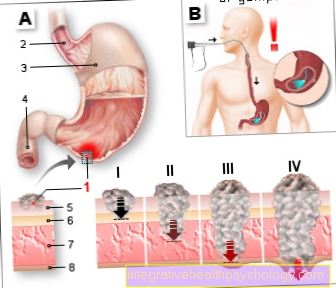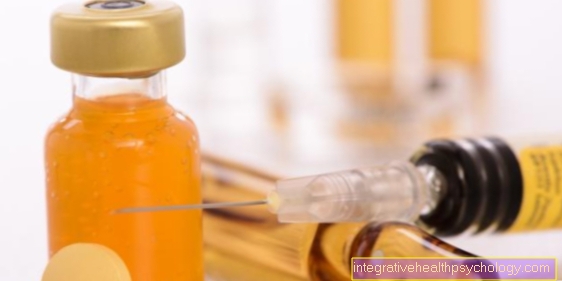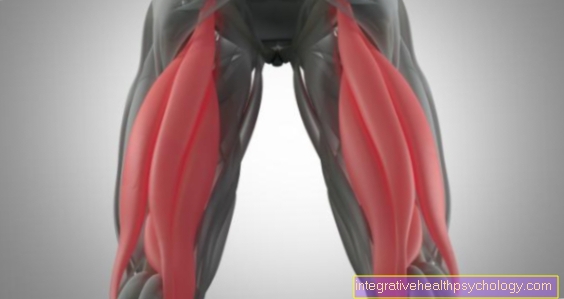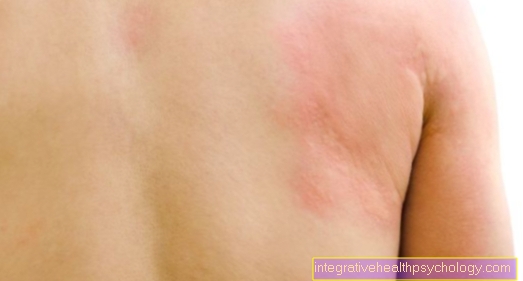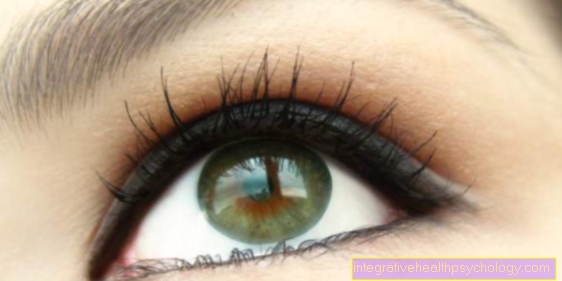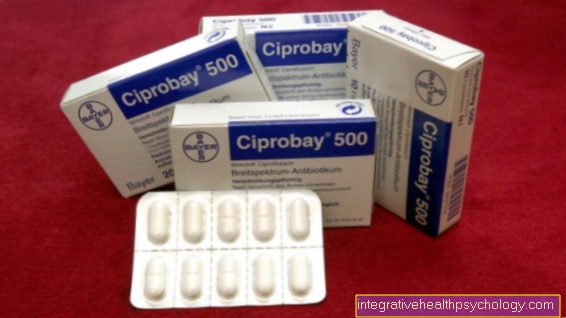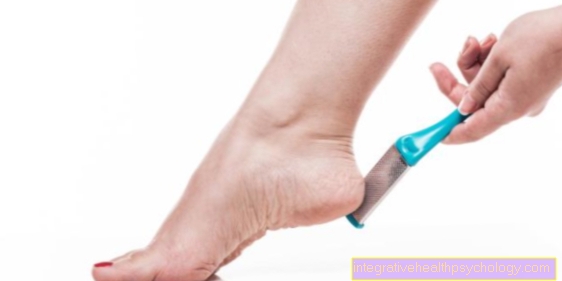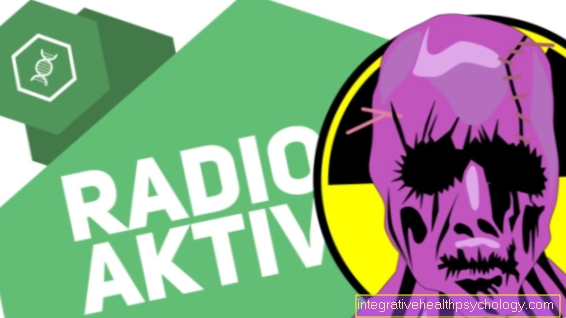Jaundice prolongatus - how dangerous is it?
What is jaundice prolongatus?
Jaundice prolongatus is jaundice (jaundice) in newborns that persists for more than two weeks after birth.
In the case of jaundice prolongatus, the bilirubin level is still significantly higher than the normal values even after the 10th day of life.
This can be recognized by the noticeable yellowing of the skin and the sclera (white of the eyes) of the child.
In most cases, jaundice prolongatus is asymptomatic.
Nevertheless, close medical monitoring of the children is required in order to be able to identify and treat a high rise in bilirubin in good time, as otherwise serious complications and long-term consequences can occur.
Also read our article on the topic: Newborn jaundice

causes
The majority of newborns (more than 60%) develop neonatal icterus (icterus neonatorum) in the first few days after birth.
This is a physiological jaundice, i.e. a normal condition.
In the womb, babies have a different form of hemoglobin (red blood pigment).
At birth, the fetal hemoglobin is broken down and replaced by adult hemoglobin, which increases the accumulation of water-insoluble bilirubin.
Bilirubin is a breakdown product of hemoglobin and is normally excreted by the liver in the bile.
Since the newborn's liver is still immature, the conversion does not occur quickly enough and the bilirubin accumulates in the blood.
From there it passes into the skin and provides the characteristic yellow color.
Usually, blood values return to normal after seven to ten days and treatment is not necessary.
With jaundice prolongatus, the bilirubin values are not normalized even after ten to fourteen days.
The causes of pathological jaundice prolongatus are very diverse and range from malnutrition to metabolic diseases or liver dysfunction in the child (e.g. hepatitis, disorders of the biliary tract, Meulengracht's disease or glucuronyltransferase deficiency) to underactive thyroid (hypothyroidism).
If the due date is too early (less than 37 + 0 weeks of gestation) or insufficient food intake can cause jaundice prolongatus.
Another cause is the increased death of red blood cells (hemolysis), as is the case with a severe infection of the newborn or with bruises (hematomas).
Treatment / therapy
In the case of mildly pronounced jaundice prolongatus, no treatment is necessary and consequential damage is very unlikely.
However, the newborn should be checked regularly via the transcutaneous bilirubin determination or blood tests in order to be able to start therapy in good time if the values rise above the limit.
In addition, it is necessary that the child drinks often and sufficiently (breast milk or wholesome baby food).
Frequent meals stimulate the intestines and promote the elimination of bilirubin in the stool.
The addition of water or tea should be avoided, as the child needs calories and no fluids (bowel movements must be encouraged!).
If the bilirubin value rises above a previously calculated limit value, jaundice prolongatus must be treated.
The therapy of choice here is phototherapy, in which the water-insoluble bilirubin is converted into a form that can be excreted by radiation.
In cases where bilirubin is very high and the newborn does not respond adequately to phototherapy, blood exchange transfusion may be considered.
The child's blood is gradually replaced with suitable donor blood (red cell concentrate) via an umbilical vein catheter.
A blood exchange transfusion is only necessary in very rare cases.
How is phototherapy carried out?
Jaundice prolongatus can be treated with phototherapy if the total bilirubin is increased above the phototherapy limit.
The newborns lie undressed under special fluorescent tubes, whereby the principle is similar to that of a solarium.
The children are turned over at regular intervals so that as much of their skin as possible can be irradiated.
To protect the eyes from the radiation, it is necessary that the newborns wear protective goggles.
The skin is then irradiated with short-wave blue light with a wavelength of 460 nanometers.
Irradiation converts the water-insoluble bilirubin that has accumulated in the blood into a water-soluble form that can be easily excreted.
Therapy usually lasts between one and two days, but in any case until the bilirubin levels have fallen below the calculated limit.
How long does jaundice prolongatus last?
If there is jaundice prolongatus, the newborn should be treated immediately with phototherapy.
The duration of treatment is one to two days, after which the yellow coloration will quickly improve.
The prognosis for jaundice prolongatus is good with appropriate therapy.
The child makes a full recovery and consequential damage does not usually occur.
What are the accompanying symptoms?
The main symptom of jaundice prolongatus is - as with every form of jaundice - the characteristic yellow coloration of the skin, which can usually be seen with the naked eye.
The yellow color can also be seen very clearly in the eyes, namely in the white skin of the eyes (sclera).
Mild jaundice prolongatus, in which the bilirubin values are below the limit value, does not cause any symptoms and - apart from the yellowing of the skin - is largely asymptomatic.
However, if the level of bilirubin in the blood increases too much, bilirubin acts as a cell toxin and causes serious complications.
The water-insoluble bilirubin can then cross the blood-brain barrier and be deposited in the brain.
As a result, there is severe damage to certain areas of the brain in the brain, one speaks of acute bilirubin encephalopathy.
The newborns are tired, yawn frequently and appear very sleepy, also known as lethargic.
The damage to the brain can also lead to pauses in breathing, fever as well as decreased consciousness and seizures.
Drinking laziness is also a very late symptom, which is indicated by a pronounced jaundice.
Acute bilirubin encephalopathy is very often fatal.
If the affected babies survive the acute phase, chronic bilirubin encephalopathy (kernicterus) occurs, which can lead to serious long-term effects.
Bilirubin encephalopathies, however, occur only very rarely, mostly jaundice prolongatus runs without symptoms or can be treated very well with phototherapy.
long-term consequences in jaundice prolongatus
Untreated jaundice prolongatus or jaundice prolongatus with a very severe course can lead to long-term sequelae.
The newborns develop the clinical picture of a chronic bilirubin encephalopathy (kernicterus).
The bilirubin passes from the blood across the blood-brain barrier into the brain, deposits itself in certain areas and causes severe damage there.
The children show paralysis of the muscles (cerebral palsy), hearing and visual disorders and mental development disorders.
Kernicterus often also leads to a decrease in intelligence.
Kernicterus is a serious illness that can lead to serious complications, including death of the child.
However, it is a very rare consequence of jaundice prolongatus.
Can you breastfeed a baby with jaundice prolongatus?
In rare cases, jaundice prolongatus is caused by breastfeeding.
In medicine one speaks of a so-called breast milk terus.
It is suspected that certain components that can be found in breast milk (possibly the enzyme beta-glucoronidase) inhibit the breakdown of the bilirubin and thus trigger jaundice prolongatus.
However, maternal stereotype is not a reason to stop breastfeeding.
However, the baby should be checked closely by the aftercare midwife or a doctor for increased bilirubin levels so that therapy can be started in good time if this should be necessary.
This is how the diagnosis is made
Icterus prolongatus is diagnosed by the characteristic yellow color of the skin.
The concentration of bilirubin in the blood can be determined with a device by the so-called transcutaneous (through the skin) bilirubin determination.
The device is briefly held against the child's scalp and the yellow color of the skin is measured.
If elevated values are found during the transcutaneous measurement, the bilirubin is determined by laboratory diagnostics from the blood.
The following values are clarified in order to determine the exact cause of the jaundice prolongatus: total bilirubin, conjugated and unconjugated bilirubin.

